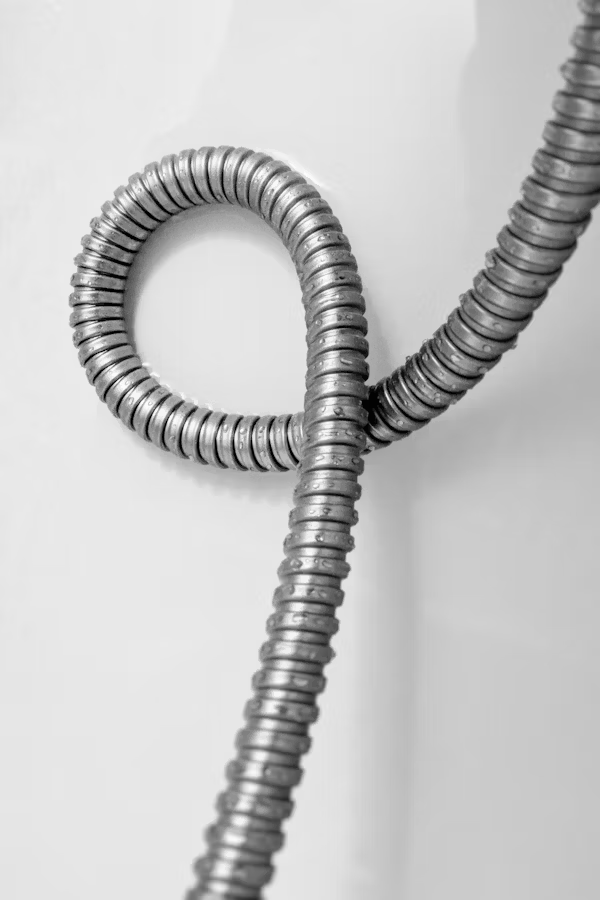Plant shutdowns happen at the worst possible moments. Three AM on a weekend when the emergency repair crew charges triple rates. Right before a critical delivery deadline when every hour of downtime costs thousands in penalties and lost contracts.
The stainless steel hose might look like overkill when you’re comparing initial prices. Until you see what happens when cheaper alternatives fail in real industrial conditions.
When “Cost-Effective” Becomes Costly
Budget-conscious buyers often gravitate towards rubber or plastic hoses. The spreadsheet math looks appealing – why spend ₹15,000 on stainless steel when rubber costs ₹3,500?
This thinking works fine until reality intervenes. Traditional hoses deteriorate in ways that sneak up on operations teams. Rubber gets stiff and cracks during the winter months in northern facilities. Plastic becomes brittle under UV exposure in outdoor installations. Chemical exposure causes gradual swelling that nobody notices until flow rates drop mysteriously.
Each premature failure triggers problems that cascade through the entire operation. Production lines stop. Quality control flags contaminated batches. Maintenance teams scramble to source replacement parts that weren’t supposed to be needed for months.
The automotive industry learned this lesson repeatedly. Assembly lines that relied on standard hoses for hydraulic systems faced frequent interruptions. Switching to stainless steel eliminated 80% of hose-related downtime in most facilities.
Heat Kills Traditional Materials Slowly
Temperature specifications look straightforward on paper. Rubber handles 85°C maximum. PTFE goes to 200°C. These numbers create false security.
Real applications rarely maintain steady temperatures. Steam systems cycle between ambient and operating temperatures multiple times daily. Chemical processing involves heating phases followed by cooling periods. Food production alternates between sanitisation temperatures and refrigerated storage conditions.
This thermal cycling destroys conventional hoses through expansion and contraction stress. Microscopic cracks develop at connection points. Flexibility decreases gradually until sudden failure occurs.
Stainless steel manages these temperature swings without degradation. Bakeries use them for direct steam injection systems that would kill rubber hoses in weeks. Chemical plants rely on them for reactor cooling lines that see 400°C peaks followed by room temperature valleys.
One pharmaceutical manufacturer tracked hose performance across identical production lines. Lines using rubber hoses replaced components every 8-12 months. Lines with stainless steel versions ran 4-5 years between scheduled replacements.
Chemical Compatibility Charts Don’t Tell the Whole Story
Compatibility databases give procurement teams confidence they shouldn’t have. These charts test immediate chemical reactions, not long-term degradation effects.
Traditional materials absorb chemicals slowly. Rubber compounds change properties as plasticisers leach out. Plastic materials develop stress cracks where aggressive cleaners attack polymer chains. These changes happen gradually enough that operators don’t notice performance degradation until catastrophic failure occurs.
Food processing facilities face particular challenges here. Sanitising chemicals used in cleaning cycles are deliberately harsh. Standard hoses absorb these compounds during cleaning, then leach residues into product streams during production runs.
A dairy processing plant discovered this problem after customer complaints about off-flavours in their premium ice cream line. Investigation revealed that rubber transfer hoses were contaminating milk with cleaning chemical residues. Switching to stainless steel hose eliminated the contamination and saved their premium product reputation.
Pressure Ratings Assume Perfect Conditions
Hose manufacturers test pressure capability under laboratory conditions. New materials, controlled temperatures, compatible test fluids, no fatigue factors. Production environments rarely match these ideal circumstances.
Age reduces pressure capability in traditional materials. Heat makes the problem worse. Chemical exposure creates weak spots that fail unpredictably. A hose rated for 10 bar might rupture at 7 bar after six months of normal service.
Manufacturing operations learned to derate pressure specifications by 30-40% to account for real-world degradation. This conservative approach works until pressure spikes occur during equipment startup or emergency shutdown sequences.
Stainless steel maintains full pressure capability throughout its service life. The material properties don’t change with age or exposure. Pressure spikes that would destroy conventional hoses cause no permanent damage to properly specified stainless alternatives.
Hydraulic systems in heavy machinery particularly benefit from this consistency. Construction equipment operators report fewer field failures after switching to stainless steel hydraulic lines.
Maintenance Requirements Nobody Calculates
Traditional hoses demand constant monitoring. Monthly visual inspections for cracking or bulging. Quarterly pressure tests to verify continuing capability. Scheduled replacements based on calendar time rather than actual condition.
These maintenance activities consume technician time that could address other critical equipment needs. A skilled maintenance worker earning ₹500 per hour spending 45 minutes monthly inspecting hoses costs ₹2,700 annually per hose location.
Multiply this across hundreds of hose installations in a typical facility, and labour costs quickly exceed material savings from choosing cheaper alternatives.
Reality Check on Limitations
Stainless steel hoses aren’t universal solutions. They cost more initially. They weigh more than traditional options. Some applications genuinely don’t need their capabilities.
Low-pressure water applications in non-critical systems might not justify the premium. Temporary installations for construction projects often use disposable approaches more economically.
But for harsh environments where failure means production losses, contamination risks, or safety hazards, stainless steel has proven itself across industries.

